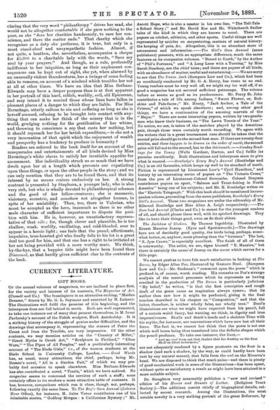. We cannot profess to have felt much satisfaction in
looking at The Raven, by Edgar Allan Poe, illustrated by Gustave Dore. (Sampson Low and Co.)—Mr. Stedman's "comment upon the poem" which is prefixed is, of course, worth reading. His remarks on Poe's strange analysis of the mental processes which he represents as having resulted in the production of The Raven is particularly judicious "My belief," he writes, "is that the first conception and rough draft of the poem came as inspiration always comes; that its author then saw how it might be perfected, giving it the final touches described in his chapter on "Composition," and that the latter, therefore, is neither wholly false, nor wholly true." Dore's illustrations are what we might have expected from his pencil, full of a certain weird fancy, bat wanting, we think, in dignity and true impressiveness. Skulls and death's-heads and a skeleton Time with his scythe, for instance, are conventions which have now lost all their force. The fact is, we cannot but think that the poem is not one which well bears being thus translated into the definite shapes which the pencil produces. To take one instance, the lines,—
" And my soul from out that shadow that lies floating on the floor 1312.ill be lifted nevermore," are not adequately rendered by a figure prostrate on the floor in a shadow (and each a shadow, by the way, as could hardly have been cast by any natural means), that falls from the owl on the Minerva's head. We are disposed to think that much pains—and there is plenty of good mechanical work in some of the illustrations—has been spent, without quite as satisfactory a result as might have been attained in a more suitable subject.






































 Previous page
Previous page